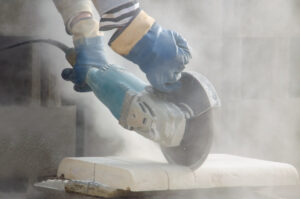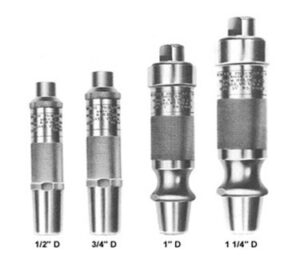
Home » Carve » Tools » Power Carving Tools » Lunch Time Tool Talk – Nov/Dec 1999
This article emerges from a lunch time question and answer discussion about power tools with Steve Sandry posing the questions, and Jason Johnston, Tom Urban, and Brian Bennan expressing their opinions on power tool performance.
For working in hard stone, and for doing certain detail work in any kind of stone, many of us have found power tools essential. Though power tools will help you accomplish the job of stock removal and finish work quickly, there are some drawbacks which include personal safety, noise, dust,just to mention a few. These issues can be fmther covered in future articles. So on to the discussion with Steve (S) posing the first question:
S: Which size compressor should one have?
Tom (T): Most compressors will run at 90 pounds of air pressure which will run most air tools (pneumatic), but you must check the CFM rating (cubic feet per minute) on the tool or the box it comes in and make sure your compressor exceeds the CFM requirements of that tool. A 5 HP compressor will usually generate enough CFM though even some 3 HP units will generate enough. Watch out for air grinders that require 20-50 CFM like you might find at Boeing Surplus or other iudustrial suppliers. Pneumatic air hammers from Trow and Holden use about 4 CFM. Working alone is no problem but running two or more will require an industrial compressor with high CFM oulput.
S: Why use compressor power as opposed to elecrric power?
T: Longevity of the tool. Air tools, when properly maintained, last longer than electric tools.
Brian (B): If you learned to sculpt with hammer and chisels, then switching to an air hammer is the next progression. It can save your body when working large pieces.
S: You would get more raw power with electric tools, would you not?
B: For cutting, yes!
S: If you were going with electric for your first tool, go with what?
B: Angle grinder. You can use the grinder with abrasive disks for sanding, or with a diamond blade for slice and dice stock reduction. Fast stock removal.
S: That’s true! Jason, what power tools do you like to use?
Jason (J): I use a lot of air grinders at the foundry, with carbide bits to do detail work. Die, pencil, and angle grinders.
S: So do you find yourself using these to carve here?
J: Yeah! Heel right at horne with them. I know how much air pressure to use
and with which carbide bits to use to create details like fingernails. I started using an angle grinder with a diamond blade to get it going, then the pneumatic chisels for large stock removal, then the grinders to not damage the surface of the stone. I’ve been working mostly in alabaster.
S: So you can actually do pneumatic carving in alabaster?
T, J, B: Sure.
B: You can do very delicate detail work using a small air hammer like the bantam or the Cuturi E. Turning dowu the air pressure and using small chisels enables you to do delicate and detail work.
S: What new tools did you see or use here at the symposium?
J: The rotary chisel in a die grinder. I didn’t think it would work at first. The triangular shape cuts really smoothly, so you can pull out concave shapes as well as make texture. I used them in soft stone. I tried it on a harder stone and it rattled a bit unless I ran it at a real high RPM. (Die grinders run approx. 20,000 RPM.)
T: That was running the smallest bit on a 1/4″ shaft. The bigger ones can walk you across the stone. They are better for wood. They advertise them for marble, but I think them best for softer stones. On the long nose die grinder you can get more control than with the short die grinders.
B: I found that the chisel Alphonso was using for detailed work on tile face of his Madonna was a treat to see. He took a small flat chisel and ground it into a carving drill. He then placed it between his hands and spun the chisel like a drill. He used it to create the deeper details in the corners of the eyes, the mouth, the nostrils, and the depths of her hair curls.
S: So let’s wrap it up talking about grinders. They seem to be a major tool around here!
T: It’s the main power tool for a sculptor. The angle grinder is. Do steel, stone, sand wood, it’s the tool for them all.
S: It’s like a table saw for a wood worker. That’s good, so what elements do you look for in an angle grinder?
B: Amperage for power, the higher the more powerful. Comfort in the grip, placement of the switch, weight and balance.
S: Is there a safety factor between a paddle switch or a top mounted push switch?
T: That’s a personal preference.
S: I find a top switch to be awkward.
B: What happens to me is that I tend to choke up on my grinder and I hit the top switch with my glove and it shuts off the grinder while I’m working. So then I have to stop what I’m focused on and restart the tools and begin again.
T: To me what’s important is the quality of the machine. For $20 you can get a 4.5″ grinder from Harbor Freight and it will get you going. If you are going with one speed (10,000 rpm), we’ve had good luck with Hitachi and Black and Deckers.
S: Industrial grade?
T: Yeah! The Hitachi is very useful; it’s rated at almost 7 amps (good power). But when you go to variable speed angIe grinders, which is the best way to go if you can afford it, we’ve had pretty good luck with the Milwaukees.
B: To have an angle grinder that you can put on a silicon carbide grinding stone, that’s rated to run at 6500 RPM, you need a grinder that you can cut down the RPMs to match the manufacturer’s maximum wheel speed. This warrants a variable speed grinder. You don’t want your grind stone flying apart because you’re running it at 10,000 RPM.
S: The other situation is using sandpaper. You burn it up if you run it too fast!
T: Everything (abrasives) run better slower. ZEK wheels run better at 67000 RPM. The 4-5″ dry diamonds are designed to run at 10,000 RPM to keep them cool. Slowing them down can wear out your diamond blade prematurely.
B: What I heard from Joanne Duby was that the adhesives used on abrasive discs to hold the abrasive to the disc, break down under high heat. So when you run them real fast you break down the adhesives and you lose the abrasives. With the Trim Cut discs, if you run them too fast you can melt the backing disc and they won’t grind or sand evenly. So I turn down the RPMs and they last a long time. They run best at 1000-1500 RPM.
S: So I’m going to reiterate: You recommend the Hitachi and Black and Decker for one speed grinding and cutting; and the Milwaukee and the Metabo for variable speed work.
B: I was watching Michael Jacobsen use a small circular tile saw to make repetitive cuts even curved cuts. He prefers using it to an angle grinder. There’s something awkward about using an angle grinder for cutting.
T: Different tools for different jobs. Michael’s doing cuts on a fairly flat surface. If you have a piece standing up in front of you, thattile saw would be quite uncomfortable to use; not so with the angle grinder.
S: So how was he making those decorative curved cuts?
T: With a smaller diameter you have less blade that penetrates the stone, the easier it is to make curved cuts.
B: I have a number of different sized diamond blades for that purpose. I can control the depth of my cut by the diameter of the blade and the clearance to the body of the grinder.
S: That’s a good point! Parting comments
B: An electric drill is also an important power tool!
S: Don’t forget the electric drill!
B: Masonry drill bits for drilling holes in your stone, like for pinning and mounting your work. Then you can upgrade to a hammerdrill for the harder stones.
T: Make sure you run the carbide tip bits at a slower RPM or you cook the bit (crack the carbide). Drill speeds vary by size of the drill. 1/2″ drill rarely goes over 500-600 RPM. 3/8″ drill runs l 000-1500 RPM. 1/4″ drill runs 20002500 RPM so don’t chuck a large bit in a 1/4″ drill and drill at 2000 RPM or you’ll bum up the bit.
B: Drills can also be used with a buffing wheel to polish your sculpture.
S: You can also put die grinder bits in a small drill to play around with and use it like a die grinder. (Play to Steve is really what we call work!)
T: One other tool I find useful is the silicon carbide stones that have 1/4″ shanks and fit in die grinders. Those things are so handy for doing unique shapes.
J: Yeah! that’s what I’ve been using all week. In a die grinder, then I use a penci I die grinder which I love.
So we end on that note, the love of tools. Thank you for your interest, and if you’d like to hear more about tools or have some specific questions, please send me an email to bberman@krl.orgorby mail to: 8025 W. Pt. Madison Rd, Bainbridge Island, WA 98110




We need some kind of descriptive text here.